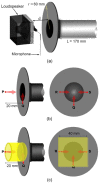Vocal Tract Resonance Detection at Low Frequencies: Improving Physical and Transducer Configurations
- PMID: 36679745
- PMCID: PMC9862109
- DOI: 10.3390/s23020939
Vocal Tract Resonance Detection at Low Frequencies: Improving Physical and Transducer Configurations
Abstract
Broadband excitation introduced at the speaker's lips and the evaluation of its corresponding relative acoustic impedance spectrum allow for fast, accurate and non-invasive estimations of vocal tract resonances during speech and singing. However, due to radiation impedance interactions at the lips at low frequencies, it is challenging to make reliable measurements of resonances lower than 500 Hz due to poor signal to noise ratios, limiting investigations of the first vocal tract resonance using such a method. In this paper, various physical configurations which may optimize the acoustic coupling between transducers and the vocal tract are investigated and the practical arrangement which yields the optimal vocal tract resonance detection sensitivity at low frequencies is identified. To support the investigation, two quantitative analysis methods are proposed to facilitate comparison of the sensitivity and quality of resonances identified. Accordingly, the optimal configuration identified has better acoustic coupling and low-frequency response compared with existing arrangements and is shown to reliably detect resonances down to 350 Hz (and possibly lower), thereby allowing the first resonance of a wide range of vowel articulations to be estimated with confidence.
Keywords: acoustic impedance; acoustic transducer; vocal tract resonance.
Conflict of interest statement
The authors declare no conflict of interest.
Figures












References
-
- Epps J., Smith J.R., Wolfe J. A novel instrument to measure acoustic resonances of the vocal tract during phonation. Meas. Sci. Technol. 1997;8:1112–1121. doi: 10.1088/0957-0233/8/10/012. - DOI
-
- Donaldson T., Wang D., Smith J., Wolfe J. Vocal tract resonances: A preliminary study of sex differences for young Australians. Acoust. Aust. 2003;31:95–98.
MeSH terms
LinkOut - more resources
Full Text Sources

